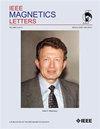Memory and Communication-in-Logic Using Vortex and Precessional Oscillations in a Magnetic Tunnel Junction
IF 1.1
4区 物理与天体物理
Q4 ENGINEERING, ELECTRICAL & ELECTRONIC
引用次数: 2
Abstract
Wearable and implantable devices (WIDs) come with several separate blocks such as preprocessing units, memory, and data transmission blocks. Hence, in this letter, we present the concept of memory and communication-in-logic (MCL) using a magnetic tunnel junction (MTJ). Here, MTJ is presented as a memory device as well as an oscillator for communication purposes. Vortex-based spin-torque nanooscillators (V-STNO) and precessional STNOs (P-STNO) generate a microwave frequency range (a few hundred MHz to a few GHz) wherein the frequency readout technique using the spin-torque diode is implemented for memory read function. In this work, a 300 nm nanodisk V-STNO generates 296 and 312 MHz frequency for two states of chirality (a characteristic of magnetic vortex), respectively. These different frequencies can be sensed for a bit “0”/ “1” read out through which the data from WIDs can be transmitted in a more energy- and area-efficient way. The output power emission is 3.22 and 1.76 µW for bit “1” and “0,” respectively, for V-STNO, which is three orders of magnitude larger than that of P-STNO. Finally, we demonstrate that V-STNO can transmit data up to 10 m in the air medium, which is much longer than P-STNO (0.24 m).利用磁隧道结中的涡流和预专业振荡实现逻辑中的记忆和通信
可穿戴和植入式设备(WID)有几个单独的块,如预处理单元、存储器和数据传输块。因此,在这封信中,我们提出了使用磁性隧道结(MTJ)的逻辑中的存储器和通信(MCL)的概念。这里,MTJ被呈现为用于通信目的的存储器设备以及振荡器。基于涡流的自旋力矩纳米振荡器(V-STNO)和进动STNO(P-STNO)产生微波频率范围(几百MHz到几GHz),其中使用自旋力矩二极管的频率读出技术被实现用于存储器读取功能。在这项工作中,300nm纳米盘V-STNO分别为两种手性状态(磁涡旋的特征)产生296和312MHz的频率。这些不同的频率可以被读出一个位“0”/“1”来感测,通过该位可以以更节能和更有效的方式传输来自WID的数据。对于V-STNO,位“1”和“0”的输出功率发射分别为3.22和1.76µW,比P-STNO大三个数量级。最后,我们证明了V-STNO可以在空气介质中传输长达10米的数据,这比P-STNO(0.24米)长得多。
本文章由计算机程序翻译,如有差异,请以英文原文为准。
求助全文
约1分钟内获得全文
求助全文
来源期刊

IEEE Magnetics Letters
PHYSICS, APPLIED-
CiteScore
2.40
自引率
0.00%
发文量
37
期刊介绍:
IEEE Magnetics Letters is a peer-reviewed, archival journal covering the physics and engineering of magnetism, magnetic materials, applied magnetics, design and application of magnetic devices, bio-magnetics, magneto-electronics, and spin electronics. IEEE Magnetics Letters publishes short, scholarly articles of substantial current interest.
IEEE Magnetics Letters is a hybrid Open Access (OA) journal. For a fee, authors have the option making their articles freely available to all, including non-subscribers. OA articles are identified as Open Access.
 求助内容:
求助内容: 应助结果提醒方式:
应助结果提醒方式:


